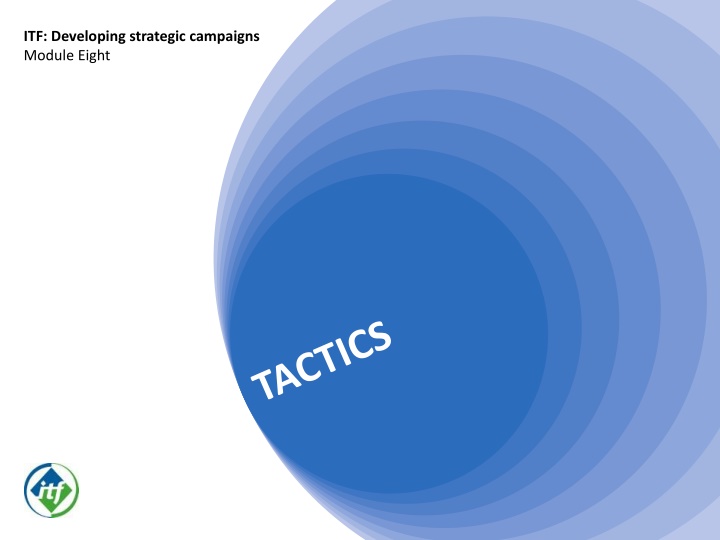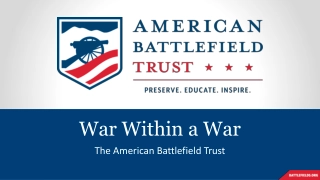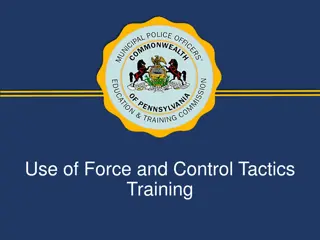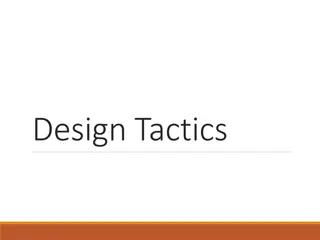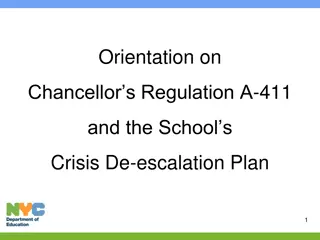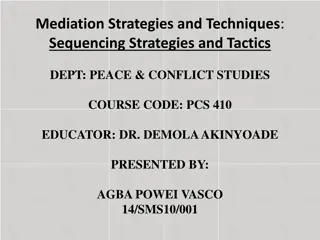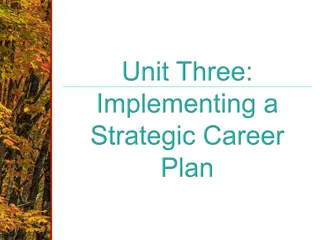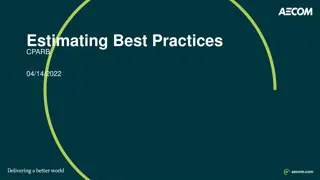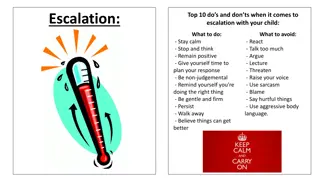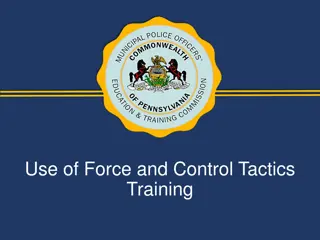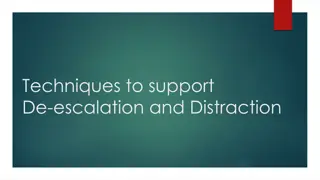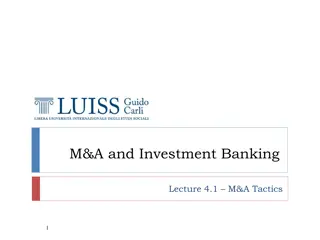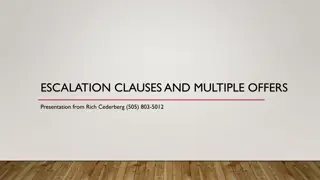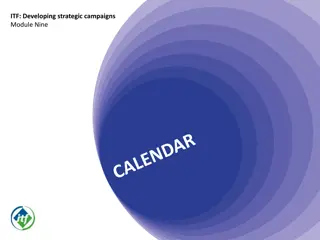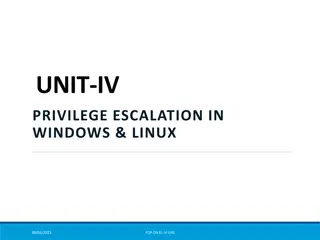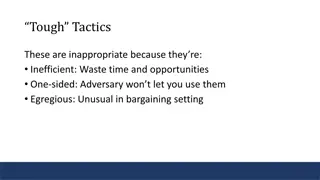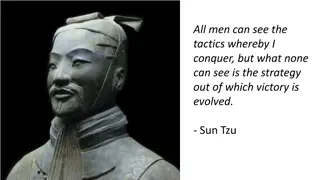Developing Strategic Campaigns - Tactics and Escalation
In the module "Developing Strategic Campaigns," learn about tactics and escalation strategies. Discover how to effectively plan and execute specific activities within a strategy to achieve desired outcomes. Explore the importance of low-risk tactics and collective actions in building momentum and participation.
Download Presentation

Please find below an Image/Link to download the presentation.
The content on the website is provided AS IS for your information and personal use only. It may not be sold, licensed, or shared on other websites without obtaining consent from the author.If you encounter any issues during the download, it is possible that the publisher has removed the file from their server.
You are allowed to download the files provided on this website for personal or commercial use, subject to the condition that they are used lawfully. All files are the property of their respective owners.
The content on the website is provided AS IS for your information and personal use only. It may not be sold, licensed, or shared on other websites without obtaining consent from the author.
E N D
Presentation Transcript
ITF: Developing strategic campaigns Module Eight
What are tactics? Individual elements of a strategy. Specific activities, usually collective. Have a date and location. ITF: DEVELOPING STRATEGIC CAMPAIGNS 2
Escalation of tactics ITF: DEVELOPING STRATEGIC CAMPAIGNS 3
Escalation Escalate from low to high intensity tactics. Compress the length of time between tactics to build momentum. ITF: DEVELOPING STRATEGIC CAMPAIGNS 4
70% or more participation You want a sign of strength to the employer, not weakness. If not enough workers want to participate, look for tactics which are lower risk or better fit the culture. ITF: DEVELOPING STRATEGIC CAMPAIGNS 5
Low risk tactics Ideal tactics are low risk for workers and impact the target. Use humour and creativity. Look for tactics which tell the truth about injustice. ITF: DEVELOPING STRATEGIC CAMPAIGNS 6
Low risk tactics Wearing the same colour clothes or armbands Petitions Distribution of information Leafleting large public events Not talking or talking about a particular problem in the workplace in a synchronised manner Competitions (example collection of money awarded to the one who is yelled at the most by the manager) Social events and celebrations ITF: DEVELOPING STRATEGIC CAMPAIGNS 7
Anything which is done collectively can become a good tactic How could you make this tactic collective? A resolution presented by top union leaders at a shareholders meeting. ITF: DEVELOPING STRATEGIC CAMPAIGNS 8
More low risk tactics Badges or stickers Investigations and reports from ally groups (NGOs, women s groups, universities ) Songs / slogans Gathering at a border crossing Phone / email / postcard protests Appeals for justice from community allies Visible positive appreciation of workplace union leaders Anonymous workers stories ITF: DEVELOPING STRATEGIC CAMPAIGNS 9
Low risk tactics surveys Keep the survey short, only 1-2 questions Report the results when you are ready Example: Has your workload increased in the last 3 months? [ ] Yes [ ] No Has your workload had a negative impact on the quality of your work? [ ] Yes [ ] No 85% of workers surveyed say their workload has increased. 75% say this has a negative impact on the quality of their work. ITF: DEVELOPING STRATEGIC CAMPAIGNS 10
Low risk tactics worker stories Distribute anonymous stories of injustice at: The workplace Sporting or social events Fairs and markets Media events Central business or transport locations Use allies (universities or NGOs) to write reports. ITF: DEVELOPING STRATEGIC CAMPAIGNS 11
Delivering the message Banners Billboards and signs Balloons Pastries or candies with messages Games Video Social and news media ITF: DEVELOPING STRATEGIC CAMPAIGNS 12
Predict how the target will respond With unusual tactics, put more effort into your relationship with the decision maker. Let them know that you are rational. You might want to meet with the target before you act. ITF: DEVELOPING STRATEGIC CAMPAIGNS 13
Planning tactics Plan your hardest hitting tactic first. Create lower impact tactics leading up to it. Involve workers in planning tactics. They are more likely to participate. ITF: DEVELOPING STRATEGIC CAMPAIGNS 14
Example: If you plan a strike, you must first: Organise a practice strike . Publicise a survey of workers showing overwhelming majority ready to strike. Deliver a truckload of picket signs to the office of a top decision maker. ITF: DEVELOPING STRATEGIC CAMPAIGNS 15
Indirect targets Focus your tactics on the indirect target. Include your campaign goals and the name of the direct target to avoid confusion. Link indirect target to a campain goal Indirect target: Grocery store with High Prices Direct target: International Trucking Co. Large letters / banners: HIGH PRICES at Apples Grocery Store Small letters: We are here today protesting high prices. In addition to high prices Apples Grocery Store uses International Trucking Co. that makes drivers work long hours, creating fatigue and unsafe road conditions in our community. ITF: DEVELOPING STRATEGIC CAMPAIGNS 16
Never stop! Keep the pressure constant. Stay on your target long enough to make a serious impact. Do not flip between targets and strategies. ITF: DEVELOPING STRATEGIC CAMPAIGNS 17
Activity: Tactics chart Aim: Create campaign tactics Tasks: Select a facilitator and timekeeper On the top left corner of the tactics chart, write in the name of your direct target. In the left column list 1-3 direct and/or indirect targets. Fill in low, medium and high tactics. Include initial contact with your target in the low intensity column. ITF: DEVELOPING STRATEGIC CAMPAIGNS 18
Activity: Tactics chart Direct target Low intensity Medium intensity High intensity Target No. 1 1. 2. 3. 1. 2. 3. 1. 2. 3. Target No. 2 1. 2. 3. 1. 2. 3. 1. 2. 3. Target No. 3 1. 2. 3. 1. 2. 3. 1. 2. 3. ITF: DEVELOPING STRATEGIC CAMPAIGNS 19
Activity: Tactics chart When you are done make sure that the tactics: Impact your direct target? Involve workers or allies in collective action? Fit with your strategy and campaign message? ITF: DEVELOPING STRATEGIC CAMPAIGNS 20
